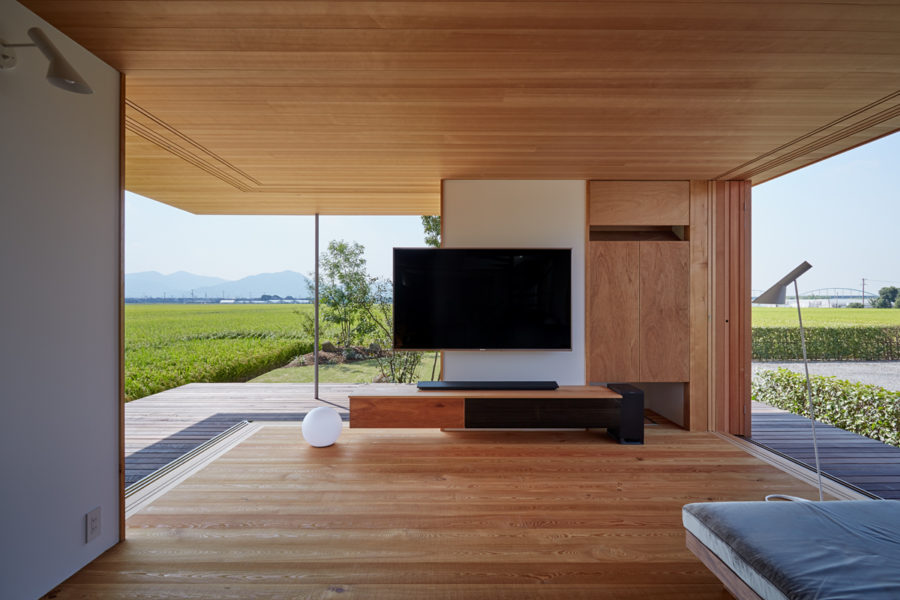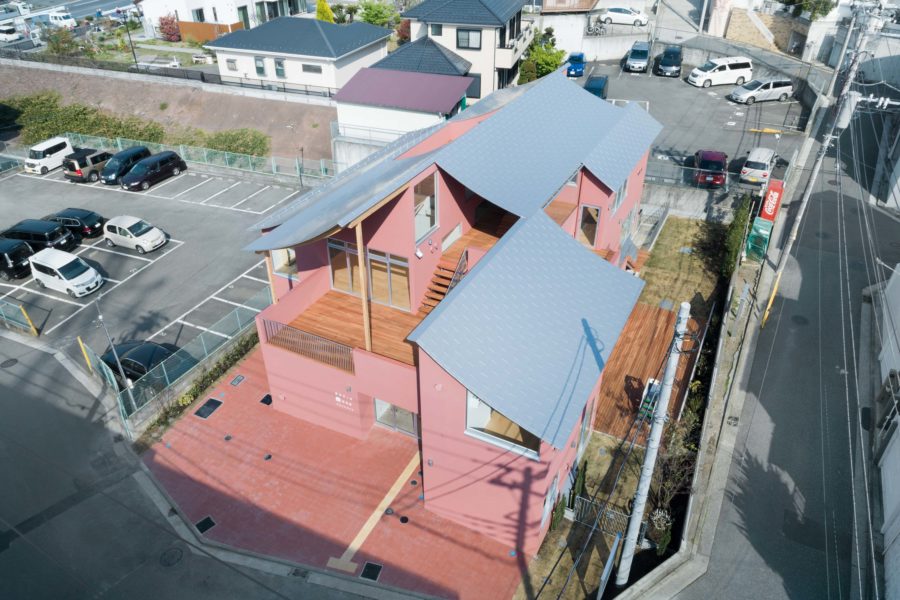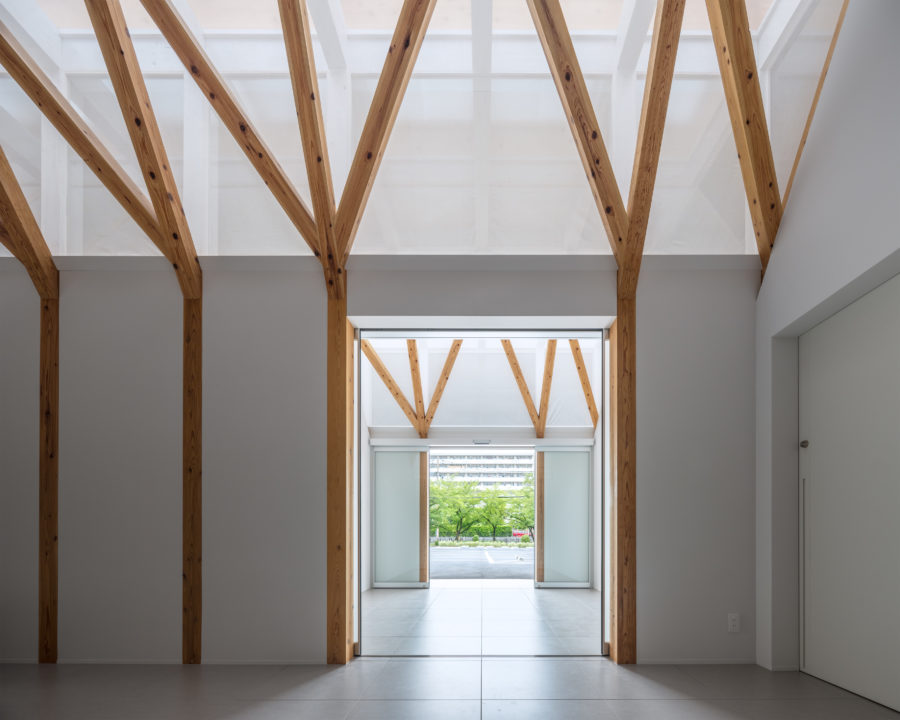子供が独立し、2人暮らしとなって久しいご夫婦が暮らす築143年の“缶詰茅葺き”民家と50年前の増築部の耐震・断熱改修である。 明治初期より受け継がれ、半世紀以上も暮らしてきた茅葺きの家屋に今後も安心して、暖かく快適に住み続けられるようにすること、また改修後でもゴールデンウィークや夏休みに集まる大勢の子供家族たちと楽しく過ごせる家が求められた。
本計画の耐震改修では、「ボックスフレーム(耐震フレーム)」というあまり見慣れない構造フレームを茅葺き建物の主架構を取り囲む形で4カ所に配置し、主たる耐震要素としてほとんどの水平力を負担させている。
「ボックスフレーム(耐震フレーム)」とは、105mm角の木材で組んだキューブ状のフレームを基礎に緊結し、X、Y、Z方向へ90mm角の筋交いを組み込んだ強固な構造物を指す。「ボックスフレーム(耐震フレーム)」を考案・採用することになったのは、以下の理由からである。
茅葺き棟の主架構にはもともとまともな壁がなく、引き戸と垂れ壁、床の間ですべてであった。これは、建具を取り外せば広い空間となることで冠婚葬祭や親戚、地域の集まりなどにも対応できる民家住宅の重要な機能であり、この柔軟な機能はクライアントの住まい方から、また明治期からの建物を残したいという要望からも残す必要があった。
しかし耐震診断では、最小評点が0.55(垂れ壁雑壁すべて含む)という結果であり、このままでは大地震時には倒壊する可能性が高いことに加え、茅葺き主屋と増築部は高さおよび重さが異なるため別々に動きやすく、一気に崩壊するリスクが高い状態であった。
そのため主屋と増築部それぞれに十分余裕のある耐力を持たせることで、変形差を抑える耐震補強が必要であると考えた。だが、そこまでの耐力をもたせる耐震改修は工期・工費ともに大きくなってしまう。加えて、住まい方の保存という条件から、主架構には壁がつくれないという予条件があった。そこで考案したのが、空間を仕切らない「ボックスフレーム(耐震フレーム)」である。
耐震フレームで十分な水平耐力(他の要素もすべて含め総合的に評点3.13)を確保できたため、既存の建物壁面の大きな解体や大規模な基礎工事も必要なくなった。躯体の健全化と新設の土間と躯体の緊結のみという比較的小規模な工事内容とでき、改修コスト縮減と工期短縮に大きく寄与している。また、フレームはベンガラで仕上げられて南側ファサードに現れ、耐震性向上のシンボルのように茅葺き民家のアクセントとなっている。
空き家問題が深刻化する中、市場には優良な中古物件がほとんど流通していない。これは法体系と不動産慣習といった要因により、木造であれば築21年以上の中古住宅の資産価値がゼロとなり、資産価値が認められない家に誰もお金をかけてメンテナンスを行わないためである。
この状態を打開すべく既存住宅インスペクション制度など、徐々に既存ストック利用がなされる流れが始まりつつあると感じている。この流れはこれからさらに加速し、臨界点を超えると一気に中古市場に今問題となっている空き家群が流れ込んでくる時代が近いのではないだろうか。
そのとき、既存建物の改修は中古物件の資産価値をエビデンスを持って確保、記録していくことが重要になっていくと考えられる。
神山の家の改修計画は、住宅医(一般社団法人住宅医協会が認定する資格)と協働し6分野(耐久性・耐震性・断熱温熱性・省エネ性・バリアフリー性・火災の安全性)について入念な調査診断を行ってから現状分析、予算との整合性を見つつ改修後の資産価値向上レベルを確認後、工事項目を決定している。(髙橋 勝)
Renovation of an old folk house that connects the past and the future with a box frame
“House of Koyama” is a 143-year-old canned thatched house and a 50-year-old extension that was earthquake-proofed and insulated by the couple, whose children have long since become independent and live alone. The couple wanted to ensure that the thatched house, which had been handed down from the early Meiji period and had been lived in for more than half a century, could continue to be lived in safely, warmly, and comfortably, and that even after the renovation, the house could be enjoyed by the many children and their families who gather there during Golden Week and summer holidays.
In the seismic retrofit of this project, unfamiliar structural frames called ‘seismic frames’ were placed in four locations around the main structure of the thatched building to bear most of the horizontal forces as the main seismic element.
The term ‘Box frame (earthquake-resistant frame)’ refers to a solid structure consisting of a cube-shaped frame of 105-square timber frames, which is tethered to the foundation and incorporates 90-square braces in the x-, y-, and z-directions. The reasons for the development and adoption of ‘Box frame (earthquake-resistant frame)’ are as follows.
The main structure of the thatched building originally had no proper walls and was made up entirely of sliding doors, hanging walls, and an alcove. This is an important function of a Minka house, which clients can use for weddings, funerals, relatives, and community gatherings by removing the fittings to create a large space, and this flexible function had to be retained due to the client’s way of living and the desire to preserve a building from the Meiji period.
However, the seismic diagnosis showed that the minimum score was 0.55 (including all hanging and miscellaneous walls). As it was likely to collapse in a major earthquake, the thatched main building and the extension were at high risk of collapsing at once, as they were of different heights and weight and could easily move separately.
Therefore, it was considered necessary to reinforce the main building and the extension with seismic reinforcement to reduce the difference in deformation by providing each with a sufficient margin of bearing capacity. However, the seismic retrofitting to provide this resistance level would have required a large construction period and cost. Furthermore, the main structure could not have walls due to the condition of preserving the way of living. Therefore, the solution was an ‘earthquake-resistant frame’ that does not partition the space.
As the earthquake-resistant frame-secured sufficient horizontal bearing capacity (overall score 3.13, including all other elements), there was no need for major demolition of the existing building walls or large-scale foundation work, and only the soundness of the frame and the bonding of the new earth floor to the frame were required. This has made a significant contribution. The frame is finished in Bengala and appears on the south façade, accentuating the thatched Minka as a symbol of improved earthquake resistance.
With the problem of vacant houses becoming more serious, few good second-hand properties are on the market. Moreover, due to the legal system and real estate practices, the asset value of second-hand wooden houses over 21 years old is zero, and no one spends money on maintenance on houses whose asset value is not recognized.
To overcome this situation, we feel that a trend towards using existing stock is gradually beginning, such as the existing house inspection system. This trend is likely to accelerate further, and when the critical point is reached, the number of empty houses, which is now a problem, will flow into the second-hand market in one fell swoop.
At that time, it will be important to secure and record the asset value of second-hand properties with evidence for the renovation of existing buildings.
The Kamiyama House refurbishment plan is based on a careful survey and diagnosis of six areas (durability, earthquake resistance, thermal insulation, energy efficiency, barrier-free, and fire safety) in collaboration with a housing doctor (a qualification accredited by the Association of Housing Doctors), followed by an analysis of the current situation, and after confirming the level of asset value improvement after refurbishment in line with the budget. Construction items are determined. (Masaru Takahashi)
【神山の家】
所在地:滋賀県甲賀市
用途:戸建住宅
クライアント:個人
竣工:2019年
設計:髙橋勝建築設計事務所
担当:髙橋 勝
構造設計:アトリエSUS4
施工:森工務店
撮影:住山 洋
工事種別:リノベーション
構造:木造
規模:地上1階
計画面積:93.17m²
設計期間:2018.08-2019.05
施工期間:2019.08-2019.12
【House of Koyama】
Location: Koka City, Shiga, Japan
Principal use: Private house
Client: Individual
Completion: 2019
Architects: Masaru Takahashi architectural design office
Design team: Masaru Takahashi
Structure engineer: Atelier SUS4
Contractor: Mori Corporation
Photographs: Hiroshi Sumiyama
Construction type: Renovation
Main structure: Wood
Building scale: 1 Story
Planning area: 93.17m²
Design term: 2018.08-2019.05
Construction term: 2019.08-2019.12








